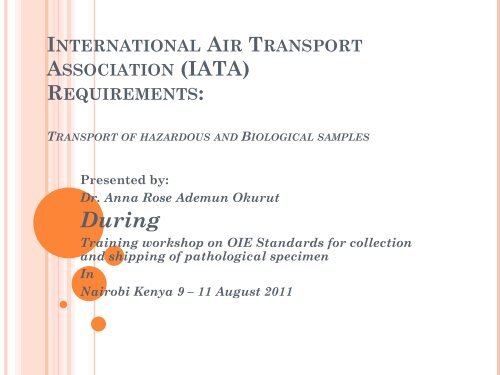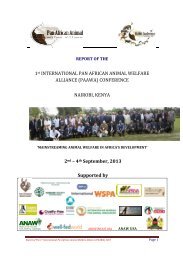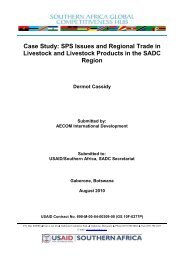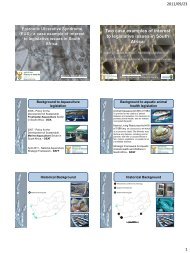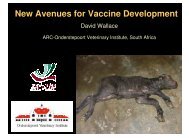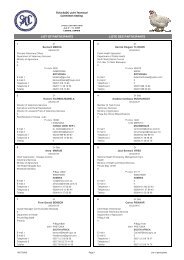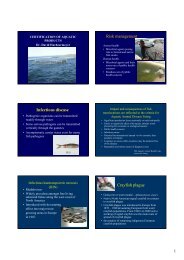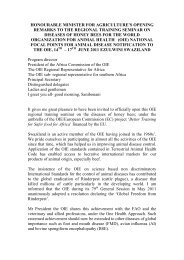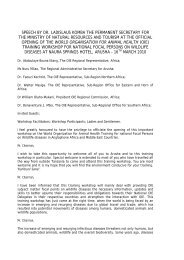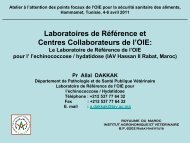Transport of Hazardous and Biological Samples - OIE Africa
Transport of Hazardous and Biological Samples - OIE Africa
Transport of Hazardous and Biological Samples - OIE Africa
Create successful ePaper yourself
Turn your PDF publications into a flip-book with our unique Google optimized e-Paper software.
INTERNATIONAL AIR TRANSPORT<br />
ASSOCIATION (IATA)<br />
REQUIREMENTS:<br />
TRANSPORT OF HAZARDOUS AND BIOLOGICAL SAMPLES<br />
Presented by:<br />
Dr. Anna Rose Ademun Okurut<br />
During<br />
Training workshop on <strong>OIE</strong> St<strong>and</strong>ards for collection<br />
<strong>and</strong> shipping <strong>of</strong> pathological specimen<br />
In<br />
Nairobi Kenya 9 – 11 August 2011
1. PRE-TEST<br />
INTRODUCTION<br />
WHO has put together guidelines to facilitate<br />
compliance with international regulations for<br />
transport <strong>of</strong> infectious substances <strong>and</strong> patient<br />
specimen by all modes <strong>of</strong> transport, nationally<br />
<strong>and</strong> internationally ensuring safe packaging <strong>and</strong><br />
transportation<br />
WHO guidelines tally with the National <strong>and</strong><br />
International <strong>Transport</strong> Regulations<br />
Safe packaging <strong>and</strong> transportation protects<br />
person packing, those in the postal, airline <strong>and</strong><br />
other transport mode by avoiding breakage or<br />
leaks in the package
INTRODUCTION<br />
Packaging <strong>of</strong> infectious substances should ensure<br />
minimal potential damage <strong>of</strong> the package but<br />
also the integrity <strong>of</strong> the specimen<br />
Timely <strong>and</strong> accurate specimen processing is<br />
important for integrity<br />
Proper <strong>and</strong> accurate labeling is very important<br />
to avoid exposure<br />
The above are important for accurate <strong>and</strong> timely<br />
diagnosis
AIMS AND GOALS OF DANGEROUS GOODS<br />
REGULATION<br />
Purpose:<br />
Establish procedures for shippers, freight<br />
forwarders <strong>and</strong> consignees<br />
Reduce transport risks<br />
Safety is the reason for the development <strong>of</strong><br />
dangerous goods regulations
INTERNATIONAL REGULATIONS<br />
The basis <strong>of</strong> all national <strong>and</strong> international<br />
regulations for the safe transport <strong>of</strong> dangerous<br />
goods are the Recommendations<br />
(“Specification”) <strong>of</strong> the “UN Committee <strong>of</strong><br />
Experts for <strong>Transport</strong>ation <strong>of</strong> Dangerous<br />
Goods” (UNCETDG) <strong>of</strong> the UN Economic <strong>and</strong><br />
social council, as published in “The Orange<br />
Book”.<br />
The WHO regulations are reflected in the<br />
international law through agreements
INTERNATIONAL REGULATIONS<br />
There are five different (relevant) Modal Authorities who each<br />
publish their own regulation manuals in which they follow "The<br />
Orange Book". These are the:<br />
The Technical Instructions for the Safe <strong>Transport</strong> <strong>of</strong> Dangerous<br />
Goods by Air published by the International Civil Aviation<br />
Authority (ICAO).<br />
The International Maritime Dangerous Goods Code (IMDG)<br />
published by the International Maritime Organization (IMO).<br />
The European Agreement concerning the International Carriage <strong>of</strong><br />
Dangerous Goods by Road (ADR) published by The United<br />
Nations Economic Commission for Europe (UNCE).<br />
The International Agreement for the Carriage <strong>of</strong> Dangerous goods<br />
by Rail (RID) published by The Intergovernmental Organization<br />
for International Carriage <strong>of</strong> Dangerous Goods by Rail (OTIF).<br />
The <strong>Hazardous</strong> Materials Regulations (Title 49 CFR Parts 100-<br />
185) published by The Office <strong>of</strong> <strong>Hazardous</strong> Materials Safety, US<br />
DOT.
TYPES OF TRANSPORTS<br />
Air: The International Civil Aviation Organization<br />
(ICAO) provides Technical Instructions for the Safe<br />
<strong>Transport</strong> <strong>of</strong> Dangerous Goods by Air regulations for<br />
controlling transportation <strong>of</strong> goods by air <strong>and</strong> apply to<br />
all international flights.<br />
The IATA is an international association that provides<br />
the Dangerous Goods Regulations which incorporate<br />
the ICAO <strong>and</strong> any other restrictions.<br />
National flights are controlled under National Civil<br />
Aviation Authorities, which usually follow ICAO <strong>and</strong><br />
any other<br />
The variations for states <strong>and</strong> operators are controlled<br />
by ICAO <strong>and</strong> IATA
TYPES OF TRANSPORTS<br />
Rail The International Carriage <strong>of</strong> Dangerous Goods by Rail<br />
(RID) regulations apply to only Europe, Middle East <strong>and</strong><br />
North <strong>Africa</strong> <strong>and</strong> 25 countries <strong>of</strong> EU through Council<br />
Directive 96/94/EC<br />
Road The European Agreement concerning the International<br />
Carriage <strong>of</strong> Dangerous Goods by Road (ADR) is for 40<br />
countries.<br />
Sea The International Maritime Organization (IMO)<br />
provides the International Maritime Dangerous Goods Code<br />
which applies to 155 countries which are contracting<br />
parties to the International Convention for safety <strong>of</strong> Life in<br />
the Sea (SOLAS)<br />
Post The Universal Postal Union (UPU) provides the Letter<br />
Post Manual regulations
PACKING GROUPS<br />
Dangerous Goods are assigned to a packing group<br />
according to their danger:<br />
Group I: high<br />
Group II: medium<br />
Group III: low<br />
However, Infectious substances (class 6.2)<br />
are not assigned to a packing group.<br />
Dry ice usually used in packing class 6.2<br />
falls in Group III
CLASSIFICATION OF DANGEROUS GOODS<br />
There are nine classes <strong>of</strong> Dangerous Goods with<br />
subdivisions within certain classes.<br />
Class 1 – Explosives<br />
Class 2 – Gases<br />
Class 3 – Flammable Liquids<br />
Class 4 – Flammable Solids<br />
Class 5 – Oxidizing Substances <strong>and</strong> Organic Peroxides<br />
Class 6 – Toxic <strong>and</strong> Infectious Substances<br />
• Division 6.1 – Toxic substances<br />
• Division 6.2 – Infectious substances<br />
Class 7 – Radioactive Material<br />
Class 8 – Corrosives<br />
Class 9 – Miscellaneous Dangerous Goods (dry ice)
TRAINING OBJECTIVE<br />
This training will concentrate on Class 6.2<br />
Infectious substances <strong>and</strong> Class 9<br />
Miscellaneous Dangerous Goods (dry ice)<br />
which are <strong>of</strong> interest to us.<br />
This training will also consider air<br />
transportation based on IATA regulations
CLASS 9 – MISCELLANEOUS<br />
DANGEROUS GOODS<br />
Miscellaneous Dangerous Goods that cannot be<br />
included in any <strong>of</strong> the other eight classes<br />
Solid carbon dioxide (dry ice) is a dangerous<br />
good<br />
Dry ice is assigned UN 1845<br />
The packing requirements for dry ice are found<br />
in Packing Instruction 904 (PI 904).<br />
Packing Group III
CLASS 6.2.INFECTIOUS SUBSTANCES<br />
Infectious substance = Infectious materials; substances<br />
known or are reasonably expected to contain<br />
pathogens<br />
• Category A – Cause permanent disability, life-threatening<br />
or fatal disease to health humans or animals.<br />
Causing disease to humans <strong>and</strong> animals are assigned UN2814 e.g.<br />
Ebola, Lassa <strong>and</strong> Marburg. Shipping name; INFECTIOUS<br />
SUSTANCES AFFECTING HUMANS<br />
Causing disease to only animals UN2900 e.g. FMD <strong>and</strong> ASF<br />
cultures. Shipping name INFECTIOUS AGENTS AFFECTING<br />
ANIMALS only<br />
• Category B – Infectious substances which do not fit in<br />
category A <strong>and</strong> are assigned UN3373 e.g. Specimen <strong>of</strong><br />
anthrax, brucellosis <strong>and</strong> FMD. Shipping name;<br />
BIOLOGICAL SUBSTANCES, CATEGORY B
CLASS 6.2.INFECTIOUS SUBSTANCES<br />
Pathogens; microorganisms <strong>and</strong> other agents<br />
such as prions which can cause disease to<br />
humans <strong>and</strong> animals except those exempted<br />
BIOLOGICAL SUBSTANCES, CATEGORY B are<br />
materials directly collected from human or<br />
animals for research, diagnosis, investigations<br />
treatment <strong>and</strong> prevention<br />
Cultures are internationally propagated<br />
pathogens
CLASS 6.2.INFECTIOUS SUBSTANCES<br />
<strong>Biological</strong> products 1) those which are manufactured<br />
<strong>and</strong> packaged in accordance with the requirements <strong>of</strong><br />
appropriate national authorities <strong>and</strong> transported for<br />
the purposes <strong>of</strong> final packaging or distribution, <strong>and</strong> use<br />
for personal health care by medical pr<strong>of</strong>essionals<br />
or individuals. (Not subject to Regulations)<br />
2) those which do not fall under paragraph (a) <strong>and</strong> are<br />
known or reasonably believed to contain infectious<br />
substances (IS) <strong>and</strong> which meet the criteria for<br />
inclusion in Category A or Category B. (Must be<br />
shipped as UN 2814, UN 2900, or UN 3373 as<br />
appropriate)
CLASS 6.2.INFECTIOUS SUBSTANCES<br />
Genetically modified microorganisms <strong>and</strong> organisms;<br />
genetic material is modified <strong>and</strong> if it can cause<br />
alteration to humans or animals it is UN3245<br />
Medical or clinical wastes; wastes derived from<br />
medical treatment <strong>of</strong> animals <strong>and</strong> humans or from<br />
biological research.<br />
• Waste from Category A shall be assigned UN2814<br />
<strong>and</strong> UN2900.<br />
• Category B wastes or considered <strong>of</strong> low risk is<br />
assigned UN3291
EXEMPTIONS - NOT SUBJECT TO REGULATIONS<br />
Substances that do not contain infectious substances<br />
Substances containing organisms that are non<br />
pathogenic<br />
Substances containing neutralized or inactivated<br />
pathogens<br />
Environmental samples that pose no risk <strong>of</strong> infection<br />
Blood or blood components collected for transfusion<br />
Tissues or organs cleared for transplantation<br />
Dried blood spots <strong>and</strong> faecal occult blood screening<br />
tests<br />
Decontaminated medical or clinical waste<br />
"Exempt" human or animal specimens (min packaging<br />
<strong>and</strong> marking)
EXEMPT HUMAN/ANIMAL PATIENT<br />
SPECIMENS:<br />
These are specimens for which there is<br />
minimal likelihood that pathogens are present<br />
packaging: less stringent triple packaging ("PI<br />
650-like")<br />
no DG documentation required<br />
a pr<strong>of</strong>essional judgment is required to<br />
determine if a substance is exempt under this<br />
paragraph
RESPONSIBILITIES IN GOODS TRANSPORTATION<br />
1. Shipper (consignor)<br />
2. Operator (carrier, freight forwarder)<br />
3. Receiver (consignee)
1. RESPONSIBILITIES OF THE SHIPPER<br />
Ensure that the articles or substances are not prohibited for<br />
transport<br />
Identify<br />
Classify<br />
Mark<br />
Label<br />
Package<br />
Document the articles <strong>of</strong>fered for transport<br />
Apply all packaging requirements<br />
Manufacturers <strong>and</strong> distributors <strong>of</strong> packaging must<br />
provide information regarding procedures to be followed to<br />
assemble the package correctly
BEFORE SHIPPING INFECTIOUS SUBSTANCES<br />
In addition, the shipper must:<br />
Make arrangements with the consignee<br />
(receiver)<br />
Make arrangements with the operator (carrier)<br />
Send the consignee all necessary<br />
documentation including import/export<br />
permits (sometimes the consignee needs to<br />
obtain the import permit), dispatch <strong>and</strong><br />
shipping documents<br />
Be aware <strong>of</strong> <strong>and</strong> follow State <strong>and</strong> Operator<br />
Variations, the right <strong>of</strong> countries <strong>and</strong> airlines<br />
to be more restrictive than the regulations.
SHIPPER’S ROLE<br />
The shipper is responsible for<br />
Classifying Dangerous Goods<br />
Providing accurate <strong>and</strong> complete<br />
identification <strong>of</strong> the Dangerous Goods<br />
Using the packing that corresponds to the<br />
class <strong>of</strong> Dangerous Goods
2. RESPONSIBILITIES OF THE OPERATOR<br />
(CARRIER, AIRLINE)<br />
Follow a consignment verification list prior to<br />
acceptance <strong>of</strong> the package.<br />
Inspect the package<br />
Reject the goods if an error is noted<br />
Notify the shipper if there are errors in<br />
labeling/marking or in the accompanying<br />
documentation<br />
Provides necessary shipping forms <strong>and</strong> instructions to<br />
the shipper<br />
Storage, loading, inspection, reporting <strong>of</strong> incidents <strong>and</strong><br />
accidents, security, recordkeeping
3. RESPONSIBILITIES OF THE CONSIGNEE<br />
Obtain all required permits/import licenses<br />
Provide to the shipper all required licenses<br />
<strong>and</strong>/or letters <strong>of</strong> authorization<br />
Arranges for timely <strong>and</strong> efficient collection on<br />
arrival<br />
Should acknowledge receipt to the sender
NOTE THAT;<br />
All infectious substances may be transported by air –<br />
there are no exceptions<br />
Dry ice <strong>and</strong> liquid nitrogen are dangerous goods<br />
Diagnostic specimens may contain infectious<br />
substances. The term diagnostic specimen is not<br />
used any longer in the context <strong>of</strong> transport regulations<br />
The transport <strong>of</strong> live animals that have been<br />
intentionally infected is prohibited<br />
The carriage <strong>of</strong> Dangerous Goods on board an aircraft<br />
in checked or carry-on baggage or on a person is<br />
strictly prohibited <strong>and</strong> is enforced by international air<br />
carriers.<br />
The use <strong>of</strong> diplomatic pouches to transport infectious<br />
substances is equally prohibited.
PERMITS<br />
Customs agents generally require import<br />
permits or licenses<br />
It is generally the shipper's<br />
responsibility to obtain permits/licenses<br />
Permits/Licenses are delivered for<br />
clearly identified, specific shipments<br />
It is imperative to underst<strong>and</strong> the<br />
provisions contained in a permit/license
PACKAGING, MARKING, LABELING AND<br />
DOCUMENTATION<br />
Category A <strong>and</strong> B pose different risks therefore<br />
require varied packaging details<br />
Requirements are determined by UNCETDG <strong>and</strong><br />
designated depending on Packaging Instructions e.g.<br />
Category A, PI602 <strong>and</strong> B PI650.<br />
NB.<br />
• Category A <strong>and</strong> B can not be carried in diplomatic pouch<br />
• Do not put different goods in inner package<br />
• Shippers should ensure save arrival <strong>of</strong> package without<br />
presenting a hazard
PACKING: DEFINITIONS<br />
PACKAGE: the complete product <strong>of</strong> the packing<br />
operation consisting <strong>of</strong> the packaging <strong>and</strong> its contents<br />
prepared for transport<br />
PACKAGING: receptacles <strong>and</strong> any other components<br />
or materials necessary for the receptacle to perform<br />
its containment function <strong>and</strong> to ensure compliance<br />
with the minimum packing requirements <strong>of</strong> the<br />
Regulations<br />
PACKING: The art <strong>and</strong> operation by which articles or<br />
substances are enveloped in wrappings <strong>and</strong>/or<br />
enclosed in packaging or otherwise secured
PACKING<br />
It is the Shipper's responsibility to ensure that all<br />
packages are prepared in accordance with all<br />
applicable packing requirements for Dangerous Goods<br />
Use only packing materials that comply with packing<br />
specifications<br />
Restrict the total quantity in a package to the limits<br />
specified in the Regulations<br />
Assemble the package exactly as specified<br />
Remove or fully delete all inappropriate labels or<br />
markings
PI650<br />
Shippers <strong>of</strong> Category B Infectious substances must<br />
comply with the Regulations.<br />
The packaging must consist <strong>of</strong> three components: (a) a<br />
primary receptacle(s); (b) a secondary packaging; <strong>and</strong><br />
(c) a rigid outer packaging as described<br />
An itemized list <strong>of</strong> contents must be enclosed between<br />
the secondary packaging <strong>and</strong> the outer packaging.<br />
A Shipper's Declaration for Dangerous Goods is not<br />
required.
PI904<br />
When carbon dioxide, (solid) dry ice is used in air<br />
transport, it must be in packaging designed <strong>and</strong><br />
constructed to permit the release <strong>of</strong> carbon dioxide gas<br />
<strong>and</strong> to prevent a build-up <strong>of</strong> pressure that could rupture<br />
the packaging.<br />
The net weight <strong>of</strong> the carbon dioxide, solid (dry ice) must<br />
be marked on the outside <strong>of</strong> the package.<br />
Dry ice MUST NOT be placed inside the primary or<br />
secondary packaging!!<br />
Put dry ice between the secondary <strong>and</strong> outer package
REFRIGERATED OR FROZEN SUBSTANCES<br />
Ice or dry ice must be placed outside the secondary<br />
packaging or in the outer packaging or an overpack.<br />
If dry ice is used, the packaging must be designed <strong>and</strong><br />
constructed to permit the release <strong>of</strong> carbon dioxide gas<br />
<strong>and</strong> to prevent a build-up <strong>of</strong> pressure that could<br />
rupture the packaging.<br />
Interior supports must be provided to secure the<br />
secondary packaging in its original position after the<br />
ice or dry ice has dissipated.<br />
If ice is used, the outside packaging or overpack must<br />
be leakpro<strong>of</strong>.
MARKING AND LABELING<br />
English must be used in addition to the<br />
language required by the State <strong>of</strong> Origin.<br />
Delete or cover any improper or unnecessary<br />
markings.<br />
All required markings must be visible <strong>and</strong><br />
placed on the package or overpack so that they<br />
are not covered or obscured by any part <strong>of</strong>, or<br />
attachment to, the packaging or any other<br />
label or marking.
MARKING AND LABELING<br />
o<br />
Hazard label for dry ice<br />
<br />
Hazard label for Category A infectious substances<br />
<br />
4G/Class 6.2/10/GB/2470<br />
<br />
Orientation label to be placed on two opposite sides
MARKING AND LABELING<br />
SHIPPER<br />
CONSIGNEE<br />
Dr. Anna Rose Ademun Okurut<br />
National Animal Disease<br />
Diagnostics <strong>and</strong> Epidemiology<br />
Centre,<br />
P. O. Box 513,<br />
Entebbe Ug<strong>and</strong>a<br />
Tel: +256 772 504 746<br />
Fax: +256 414 320 182<br />
Emergency Contact 24h/24h<br />
Dr. Chrisostom Ayebazibwe<br />
+256 772 626215<br />
Infectious Substance<br />
Affecting Humans<br />
UN 2814 Net Qty 40 ml<br />
Dry Ice X 15 Kgs Net<br />
Un 1845 Classe9<br />
Dr. Alex Fmddiagnosis<br />
Institute for Animal Health,<br />
Pirbright Laboratory, Ash Road,<br />
Pirbright Woking,<br />
Surrey GU24 0NF<br />
United Kingdom
TRIPLE PACKAGING SUMMARY<br />
Category A (PI 602) Category B (PI 650) Exempt human or<br />
animal specimens<br />
• Leak pro<strong>of</strong> primary<br />
• Leak pro<strong>of</strong> secondary<br />
• 95 kPa pressure test<br />
• Rigid outer<br />
• Minimum 100 mm x 100mm<br />
• Absorbent material<br />
• 9 meter drop test<br />
• 7 kg penetration test<br />
• UN marks <strong>and</strong> labels<br />
• Full DG documentation<br />
Leak pro<strong>of</strong> primary<br />
• Leak pro<strong>of</strong> secondary<br />
• 95 kPa pressure test<br />
• Rigid outer<br />
• at least one surface :<br />
min 100 mm x 100 mm<br />
• Absorbent material<br />
• 1.2 meter drop test<br />
• 3373 mark<br />
• Leakpro<strong>of</strong> primary<br />
• Leakpro<strong>of</strong> secondary<br />
• Adequate outer<br />
• at least one surface:<br />
min 100 mm x 100 mm<br />
• Absorbent material
UN MARKING SYSTEM<br />
The U.N. marking system indicates several<br />
characteristics <strong>of</strong> the packaging, as well as<br />
information on the test levels the packaging<br />
has successfully passed. Because these test<br />
levels are related to the hazard level <strong>and</strong><br />
physical <strong>and</strong> chemical characteristics <strong>of</strong> the<br />
substance to be filled, the markings also<br />
indicate some <strong>of</strong> the properties <strong>of</strong> the materials<br />
that may be packed in each container.
EXAMPLE OF UN MARKING/PROPER SHIPPING NAME (PSN)<br />
This marking comprises:<br />
4G/Class 6.2/11/GB/2470<br />
• the United Nations packaging symbol<br />
• an indication <strong>of</strong> the type <strong>of</strong> packaging (in this example a fibreboard box (4G))<br />
• an indication that the packaging has been specially tested to ensure that it meets<br />
the requirements for Category A infectious substances (Class 6.2)<br />
• the last two digits <strong>of</strong> the year <strong>of</strong> manufacture (in this example 2011)<br />
• the competent state authority that has authorized the allocation <strong>of</strong> the mark (in<br />
this example GB, signifying Great Britain)<br />
• the manufacturer’s code specified by the competent authority (in this example<br />
2470)<br />
Users shall be provided with clear instructions as to how the package should be<br />
filled <strong>and</strong> prepared for transport.
LABELS<br />
There are 2 types <strong>of</strong> labels:<br />
Hazard Labels: in the form <strong>of</strong> a square set at an angle<br />
<strong>of</strong> 45°; required for the majority <strong>of</strong> dangerous goods in<br />
all classes<br />
H<strong>and</strong>ling Labels: in various rectangular sizes;<br />
required either alone or in addition to hazard labels,<br />
for some dangerous goods
LABELS<br />
Minimum dimension <strong>of</strong> labels is 100mm x 100mm<br />
For small packages the dimensions may be smaller<br />
(50mm x 50mm). Remember minimum package is<br />
(100mm x 100mm)
PACKAGE ORIENTATION LABELS<br />
Packages containing infectious substances in liquid<br />
form must be packed so that the closure(s) <strong>of</strong> the inner<br />
packaging(s) are upright<br />
<br />
The upright position <strong>of</strong> the packaging must be<br />
indicated by 2 "package orientation labels" affixed on<br />
opposite sides <strong>of</strong> the packaging if the volume <strong>of</strong> the<br />
primary receptacles exceeds 50 ml<br />
A label "This side up" or "This end up" may also be<br />
displayed on the top cover <strong>of</strong> the package
OVERPACKS<br />
“Overpack” is the term used when several packages<br />
are combined to form one unit <strong>and</strong> sent to the same<br />
destination by a single shipper.<br />
When refrigerants are used to protect contents, the<br />
overpacks may comprise insulated vessels or flasks.<br />
Whenever an overpack is used, the required marks<br />
<strong>and</strong> labels shown on the outer packaging must be<br />
repeated on the outermost layer <strong>of</strong> the overpack. This<br />
requirement applies to infectious substances in<br />
Categories A <strong>and</strong> B.<br />
Overpacks are also required to be marked with the<br />
word “overpack”.<br />
The outer packaging must show all markings <strong>and</strong><br />
labels that are affixed to inner receptacles.
2. LABELING<br />
EXERCISE
SHIPPER'S CHECKLIST<br />
A Shipper's Declaration has ISO A4 format <strong>and</strong> is<br />
printed in red <strong>and</strong> black on a white background<br />
Complete the Shipper's Declaration in English<br />
Complete a minimum <strong>of</strong> 3 copies <strong>of</strong> the Shipper's<br />
Declaration<br />
The operator will not accept a declaration that has<br />
been altered or amended, unless the alteration or<br />
amendment to an entry has been signed by the shipper<br />
with the same signature used to sign the document.<br />
Some carriers require typed or computer generated<br />
text<br />
The maximum net quantity (weight or volume) per<br />
package allowed on passenger aircraft is 50 ml or 50 g
DOCUMENTATION<br />
A shipper's declaration <strong>of</strong> Dangerous Goods for<br />
Category A infectious substances (or for dry ice)<br />
NB. To always be filled in English<br />
An air waybill
DOCUMENTATION<br />
For shipments <strong>of</strong> Category A samples (PI602) it is<br />
m<strong>and</strong>atory to accurately <strong>and</strong> fully complete the<br />
Shipper's Declaration <strong>and</strong> the Air Waybill.<br />
These documents, signed by the shipper, constitute the<br />
legal contract between the shipper <strong>and</strong> the<br />
operator/transport company.<br />
Only the shipper may fill out <strong>and</strong> sign the Shipper's<br />
Declaration. In so doing, the shipper accepts full<br />
responsibility for the information provided.
DOCUMENTATION (SHIPPERS DECLARATION ; SD )<br />
Shipper: Full name, address <strong>and</strong> telephone number<br />
Consignee: Full name <strong>and</strong> address; telephone number<br />
<strong>and</strong> name <strong>of</strong> responsible person<br />
Air Waybill Number: Number <strong>of</strong> Air Waybill to which<br />
the declaration form will be attached<br />
Page __ <strong>of</strong> __ pages: Enter the page number <strong>and</strong> total<br />
number <strong>of</strong> pages <strong>of</strong> the Shipper's Declaration<br />
Aircraft Limitations: Delete the lable box which does<br />
not apply<br />
Shipment Type: Delete “radioctive” if the shipment<br />
does not contain radioactive material<br />
Additional h<strong>and</strong>ling information: Provide emergency<br />
contact <strong>and</strong> name <strong>of</strong> responsible person
DOCUMENTATION; SHIPPER'S DECLARATION (SD)<br />
Shipper's responsibilities for each shipment:<br />
Use the proper forms<br />
Fill out the form accurately, completely <strong>and</strong> legibly<br />
While h<strong>and</strong> written SD is permitted under the<br />
regulations, types or computer generated text is<br />
required by some carriers<br />
Sign the form before giving it to the operator<br />
The signature must be h<strong>and</strong>written<br />
Any modifications or alterations on the forms must be<br />
signed by the shipper.
DOCUMENTATION; SD, SHIPPER’S CORRECT FORM<br />
The Shipper's Declaration Form must be printed in red<br />
<strong>and</strong> black on white paper. The left <strong>and</strong> right margin<br />
diagonal striations must be printed in red.<br />
In addition to the languages required by the State <strong>of</strong><br />
Origin, English should be used The Shipper's<br />
Declaration Form should be filled out in English.<br />
The shipper must complete THREE (3) copies <strong>of</strong> the<br />
Shipper's Declaration form. The Shipper retains one<br />
copy <strong>and</strong> remits the other copies, with the packages, to<br />
the operator.
DOCUMENTATION SD<br />
The section on “Nature <strong>and</strong> Quantity <strong>of</strong> Dangerous<br />
Goods” must be completed in English as follows:<br />
UN Number: (from Column 2) UN or ID number<br />
Proper shipping name: (from Column 1) enter the<br />
proper shipping name <strong>and</strong> technical name in brackets.<br />
If unknown, write "suspected category A infectious<br />
substance"<br />
Class or division: class or division<br />
Packing Group: does not apply to infectious<br />
substances, but Group III packaging must be used if<br />
dry ice is used.<br />
Secondary Risks: none for infectious substances
DOCUMENTATION<br />
Quantity <strong>and</strong> type <strong>of</strong> Packing: Total net<br />
quantity <strong>of</strong> dangerous goods <strong>and</strong> outer<br />
packaging material<br />
Packing Instructions:<br />
– 602 for Category A infectious substances<br />
– 904 for dry ice
DOCUMENTATION; SD<br />
Certification Statement: The declaration must<br />
contain the following certification statement: “I hereby<br />
declare that the contents <strong>of</strong> this consignment are fully<br />
<strong>and</strong> accurately described above by the proper shipping<br />
name, <strong>and</strong> are classified, packaged, marked <strong>and</strong><br />
labeled/placarded, <strong>and</strong> are in all respects in proper<br />
condition for transport according to applicable<br />
international <strong>and</strong> national governmental regulations.”<br />
For air transport, the following additional statement is<br />
required: “I declare that all applicable air transport<br />
requirements have been met.”<br />
Name <strong>and</strong> title <strong>of</strong> Signatory: Enter the name <strong>and</strong><br />
title <strong>of</strong> the person signing the declaration.<br />
Place <strong>and</strong> Date: Enter the place <strong>and</strong> date <strong>of</strong> signing<br />
the declaration form
DOCUMENTATION; SD<br />
Signature: The declaration must be signed <strong>and</strong> dated<br />
by the shipper.<br />
Air Waybill number: Enter the number <strong>of</strong> the Air<br />
Waybill to which the declaration form will be attached.<br />
This may be entered or amended by the shipper or by<br />
the operator or h<strong>and</strong>ling agent.<br />
Departure <strong>and</strong> destination airports: Enter the full<br />
name <strong>of</strong> the airports or cities. These may be entered or<br />
amended by the shipper, shipper's agent or the<br />
operator.
AIR WAYBILL<br />
This is the st<strong>and</strong>ard shipping document for all<br />
shipments <strong>of</strong> goods by air<br />
The shipper or operator may complete the Air<br />
Waybill<br />
When shipping Category A infectious<br />
substances, the Air Waybill must include the<br />
following statement: “Dangerous Goods –<br />
Shipper's Declaration attached”
AIR WAYBILL<br />
When shipping packages with dry ice under Instruction<br />
650 (shipper's declaration not required), the following<br />
must be included, in sequence, in the "Nature <strong>and</strong><br />
Quantity <strong>of</strong> Goods" box <strong>of</strong> the air waybill:<br />
UN Number<br />
Proper shipping name<br />
Class or division<br />
Subsidiary risk (if any)<br />
Packing group<br />
Number <strong>of</strong> packages <strong>and</strong> net quantity per package<br />
Packing instruction<br />
For carbon dioxide it is not necessary to show the<br />
packing group <strong>and</strong> packing instruction on the air<br />
waybill
PACKAGE ACCEPTANCE<br />
Before accepting a package, staff<br />
<strong>of</strong> the shipping company as well<br />
as those persons responsible for<br />
accepting goods must inspect the<br />
package to see whether it has<br />
the proper labels <strong>and</strong> markings,<br />
<strong>and</strong> the documents, to make sure<br />
they are filled out correctly.
COMMON SHIPPING PROBLEMS<br />
Incorrect documentation<br />
Lack <strong>of</strong> training<br />
Carelessness<br />
Insufficient/invalid importexport<br />
customs papers
DOCUMENTATION AND LABELING FOR A SHIPMENT OF<br />
INFECTIOUS SUBSTANCES IN CATEGORY A<br />
Shipper's Declaration for Dangerous<br />
Goods<br />
Air waybill<br />
Import/export permit<br />
Shipper's Training (on transportation <strong>of</strong><br />
dangerous goods)<br />
Packing instruction 602<br />
Weight <strong>and</strong> volume limitations
INFECTIOUS SUBSTANCES INCLUDED IN CATEGORY A<br />
UN 2814<br />
Infectious<br />
substances<br />
affecting<br />
humans<br />
Bacillus anthracis (cultures only)<br />
Brucella abortus (cultures only)<br />
Brucella melitensis (cultures only)<br />
Brucella suis (cultures only)<br />
Burkholderia mallei [Pseudomonas mallei – Gl<strong>and</strong>ers](cultures only)<br />
Burkholderia pseudomallei [Pseudomonas pseudomallei] (cultures only)<br />
Chlamydia psittaci [avian strains] (cultures only)<br />
Clostridium botulinum (cultures only)<br />
Coccidioides immitis (cultures only)<br />
Coxiella burnetii (cultures only)<br />
Crimean-Congo hemorrhagic fever virus<br />
Dengue virus (cultures only)<br />
Eastern equine encephalitis virus (cultures only)<br />
Escherichia coli, verotoxigenic (cultures only)<br />
Ebola virus<br />
Flexal virus<br />
Francisella tularensis (cultures only)<br />
Guanarito virus<br />
Hantaan virus<br />
Hanta virus pulmonary syndrome<br />
Hendra virus<br />
Hepatitis B virus (cultures only)<br />
Herpes B virus (cultures only)<br />
Human immunodeficiency virus (cultures only)<br />
Highly pathogenic avian influenza virus (cultures only)<br />
Japanese Encephalitis virus (cultures only)<br />
Junin virus<br />
Kyasanur Forest disease virus<br />
Lassa virus<br />
Machupo virus<br />
Marburg virus<br />
Monkeypox virus<br />
Mycobacterium tuberculosis (cultures only)<br />
Nipah virus<br />
Omsk hemorrhagic fever virus<br />
Poliovirus (cultures only)<br />
Rabies virus (cultures only)<br />
Rickettsia prowasekii (cultures only)<br />
Rickettsia rickettsii (cultures only)<br />
Rift Valley fever virus (cultures only)<br />
Russian spring-summer encephalitis virus (cultures only)<br />
Sabia virus<br />
Shigella dysenteriae type 1 (cultures only)<br />
Tick-borne encephalitis virus (cultures only)<br />
Variola virus<br />
Venezuelan equine encephalitis virus (cultures only)<br />
West Nile virus (cultures only)<br />
Yellow fever virus (cultures only)<br />
Yersinia pestis (cultures only)
INFECTIOUS SUBSTANCES INCLUDED IN CATEGORY B<br />
UN 2900<br />
Infectious<br />
substances<br />
affecting<br />
animals<br />
only<br />
<strong>Africa</strong>n swine fever virus (cultures only)<br />
Avian paramyxovirus Type 1 [Velogenic Newcastle disease<br />
virus (cultures only)<br />
Classical swine fever virus (cultures only)<br />
Foot <strong>and</strong> mouth disease virus (cultures only)<br />
Lumpy skin disease virus (cultures only)<br />
Mycoplasma mycoides [Contagious bovine pleuropneumonia]<br />
(cultures only)<br />
Peste des petits ruminants virus (cultures only)<br />
Rinderpest virus (cultures only)<br />
Sheep-pox virus (cultures only)<br />
Goatpox virus (cultures only)<br />
Swine vesicular disease virus (cultures only)<br />
Vesicular stomatitis virus (cultures only)
IDENTIFICATION<br />
LIST OF DANGEROUS GOODS RELATED TO THE TRANSPORT OF IFECTIOUS SUBSTANCES<br />
Passenger <strong>and</strong> cargo aircraft<br />
Cargo aircraft only<br />
Proper Shipping Name<br />
UN No.<br />
Class or<br />
division<br />
Sub-sidiary<br />
Risk<br />
Labels<br />
State variations<br />
Operator<br />
variations<br />
Special<br />
provisions<br />
UN Packaging<br />
group<br />
Limited quantity<br />
Packaging<br />
instruction<br />
Max. net qty per<br />
package<br />
Packaging<br />
instuction<br />
Max. net qty per<br />
package<br />
Packaging<br />
indtruction<br />
Max. net qty<br />
per package<br />
1 2 3 4 5 6 7 8 9 10 11 12 13 14 15<br />
Aviation reqired liduid n.o.s<br />
<strong>Biological</strong> substance,Category B<br />
Biomedical waste<br />
Carbon dioxide, solid Dry ice<br />
Clinical waste, unspecified, n.o.s<br />
3334 9 Miscellaneous A27 A48 _ _ 906 906 2201<br />
3373 6.2 _ _ see 650 see 650<br />
3291 6.2 Infectiuos subst. A117 II _ _ 622 No limit 622 No limit<br />
1845 9 Miscellaneous A48 A151 III _ _ 904 200kg 904 200 kg<br />
3291 6.2 Infectiuos subst. A117 II _ _ 622 No limit 622 No limit<br />
Ethanol<br />
Ethanol solution<br />
alcohol<br />
alcohol solution<br />
Ethyl<br />
Ethyl<br />
1170 3 Flamm. Liquid<br />
A3<br />
A58<br />
A148<br />
II Y350 11 305 51 307 601<br />
III Y309 101 309 601 310 2201<br />
Formaldehyde<br />
2209 8 Corrosive III Y818 11 818 51 820 601<br />
Genetically modified micro-organisms<br />
Genetically modified organisms<br />
Infectious substance, affecting humans(liquid)<br />
Infectious substance, affecting humans(solid)<br />
Infectious substance, affecting animals only<br />
(liquid)<br />
Infectious sustance, affecting animals only<br />
(solid)<br />
Medical waste, n.o.s<br />
Methanol<br />
3245 9 Miscellaneous A47 _ _ 913 No limit 913 No limit<br />
2814 6.2 Infectiuos subst. A81 A140 _ 602 50 ml 602 41<br />
2814 6.2 Infectiuos subst. A81 A140 _ _ 602 50 g 602 4 kg<br />
2900 6.2 Infectiuos subst. A81 A140 _ _ 602 50 ml 602 41<br />
2900 6.2 Infectiuos subst. A81 A140 _ _ 602 50 g 602 4 kg<br />
3291 6.2 Infectiuos subst. A117 II _ _ 622 No limit 622 No limit<br />
1230 3 6.1 Flamm. Liquid A104 A113 II Y305 11 305 11 307 601<br />
1977 2.2<br />
Non-flammable gas &<br />
cryogenic liquid<br />
A152 _ _ 202 50 kg 202 500 kg<br />
Nitrogen, refridgerated liquid<br />
Regulated medical waste<br />
3291 6.2 Infectiuos subst. A117 II _ _ 622 No limit 622 No limit
3. SHIPPER DECLARATION<br />
EXERCISE,<br />
4. EXERCISE,<br />
5. TEST,<br />
6. COMPETENCY TEST
REFERENCES<br />
<br />
Guidance on regulations for the <strong>Transport</strong> <strong>of</strong><br />
Infectious Substances 2011–2012<br />
(WHO/HSE/IHR/2010.8)<br />
Guidelines on regulations for the<br />
<strong>Transport</strong>ation <strong>of</strong> Infectious Substances<br />
2007 – 2008 (WHO/CDC/EPR/2007.2)<br />
Guiding Principles For The Development<br />
Of The Un Model Regulations, First version<br />
(2008)


